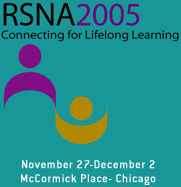
Abstract Archives of the RSNA, 2005
Nagina Malguria MD, Presenter: Nothing to Disclose
Jeffrey Charles Weinreb MD, Abstract Co-Author: Nothing to Disclose
Shirley M. McCarthy MD, PhD, Abstract Co-Author: Nothing to Disclose
To evaluate the utility of MR in pregnant patients with clinically suspected appendicitis and indeterminate or normal ultrasound.
16 pregnant patients with clinical suspicion of appendicitis and an indeterminate ultrasound were included. 9 of these patients were in the first trimester, 3 in the second and 4 in the third trimester. MRI was performed on a 1.5 T sanner using SSFSE sequences in three planes. No oral contrast was used. The MR criteria for positivity included thickening of the appendiceal wall, a dilated lumen measuring more than 6mm, increased intensity of periappendiceal tissue on T2 sequences. A negative result consisted of a normal visualized appendix with no signs of inflammation. Patients with a nonvisualized appendix and no abnormal findings were placed in the indeterminate category. Surgical and/or clinical follow up was obtained in all these cases.
All 3 MRs that were read as positive for appendicitis, had surgically confirmed appendicitis.
Of the remaining 13 patients, a normal appearing appendix was visualized in 6 patients. One of these 6 patients underwent a laparoscopy for severe continued symptoms which confirmed the absence of appendicitis. This patient was treated for pyelonephritis since she had a dilated pelvicalyceal system on imaging and right sided pain. Another patient was treated presumptively for E. Coli urinary tract infection with relief of symptoms. 7 patients were placed in the indeterminate category. One of these patients had hydronephrosis and hydroureter on the MRI. This patient had a distal ureteral stone on cystoscopy, she had relief of symptoms with stent placement. The remaining 5 patients within the negative category and 6 patients in the indeterminate category had a benign clinical course with resolution of symptoms. Of the sixteen patients, 2 patients had a normal ultrasound and fourteen had indeterminate results. Of the two normal ultrasounds, one patient was read as positive on MR and confirmed to have a perforated appendicitis at surgery.
In pregnant patients with a clinical suspicion of appendicitis ,and an indeterminate or normal ultrasound, MR is very useful (Positive Predictive Value 100%).
To evaluate the utility of MR in pregnant patients with clinically suspected appendicitis and indeterminate or normal ultrasound.
16 pregnant patients with clinical suspicion of appendicitis and an indeterminate ultrasound were included. 9 of these patients were in the first trimester, 3 in the second and 4 in the third trimester. MRI was performed on a 1.5 T sanner using SSFSE sequences in three planes. No oral contrast was used. The MR criteria for positivity included thickening of the appendiceal wall, a dilated lumen measuring more than 6mm, increased intensity of periappendiceal tissue on T2 sequences. A negative result consisted of a normal visualized appendix with no signs of inflammation. Patients with a nonvisualized appendix and no abnormal findings were placed in the indeterminate category. Surgical and/or clinical follow up was obtained in all these cases.
All 3 MRs that were read as positive for appendicitis, had surgically confirmed appendicitis.
Of the remaining 13 patients, a normal appearing appendix was visualized in 6 patients. One of these 6 patients underwent a laparoscopy for severe continued symptoms which confirmed the absence of appendicitis. This patient was treated for pyelonephritis since she had a dilated pelvicalyceal system on imaging and right sided pain. Another patient was treated presumptively for E. Coli urinary tract infection with relief of symptoms. 7 patients were placed in the indeterminate category. One of these patients had hydronephrosis and hydroureter on the MRI. This patient had a distal ureteral stone on cystoscopy, she had relief of symptoms with stent placement. The remaining 5 patients within the negative category and 6 patients in the indeterminate category had a benign clinical course with resolution of symptoms. Of the sixteen patients, 2 patients had a normal ultrasound and fourteen had indeterminate results. Of the two normal ultrasounds, one patient was read as positive on MR and confirmed to have a perforated appendicitis at surgery.
In pregnant patients with a clinical suspicion of appendicitis ,and an indeterminate or normal ultrasound, MR is very useful (Positive Predictive Value 100%).
Malguria, N,
Weinreb, J,
McCarthy, S,
The Utility of MR in Diagnosing Appendicitis in Pregnant Patients with Indeterminate or Normal Ultrasound. Radiological Society of North America 2005 Scientific Assembly and Annual Meeting, November 27 - December 2, 2005 ,Chicago IL.
http://archive.rsna.org/2005/4409473.html

